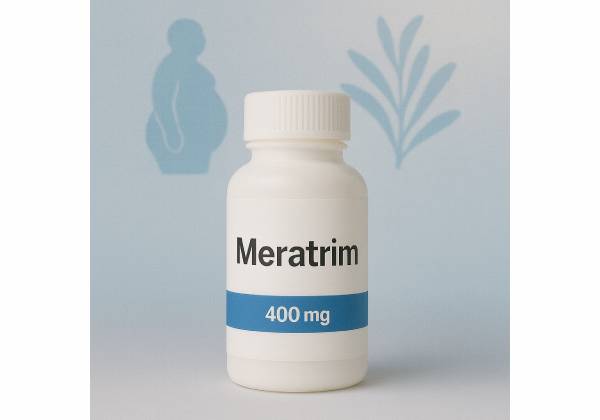
Meratrim is a branded botanical blend made from two plant extracts: the flower heads of Sphaeranthus indicus and the fruit rinds of Garcinia mangostana (mangosteen). In modern research, this combination has been studied for weight management in adults with overweight or obesity who also follow modest diet and activity guidance. Reported benefits include statistically significant weight loss over 8–16 weeks, reductions in waist and hip circumference, and improvements in blood lipids. In cell and animal models, Meratrim appears to influence fat storage and energy use—downregulating enzymes that build fat and nudging cells toward burning more fuel.
This guide explains what Meratrim is, how it seems to work, the strength of the evidence, how to take it, who is most likely to benefit, and who should avoid it. You will find practical advice on timing, expectations, and common mistakes so you can decide, with your clinician, if Meratrim fits your plan. The aim is clarity: plain language, realistic outcomes, and a balanced view of benefits and risks based on the best available research.
Quick Overview
- In randomized research with diet and daily walking, 800 mg/day for 16 weeks produced about 5 kg average weight loss and reduced waist size by ~10 cm versus placebo.
- Lab and animal data suggest decreased fat formation and increased energy use via fatty acid synthase downregulation and AMPK-related pathways.
- Typical dosage: 400 mg twice daily (total 800 mg/day) for 8–16 weeks alongside calorie control and regular walking.
- Safety caveat: short-to-medium term trials report good tolerability; long-term safety and use with multiple medications remain less certain.
- Avoid if pregnant or breastfeeding, under 18, or if you have a significant medical condition without medical supervision.
Table of Contents
- What is Meratrim and how it works
- Does Meratrim work for weight loss?
- How to take Meratrim effectively
- Who benefits most, and what to expect
- Common mistakes and troubleshooting
- Safety, side effects, and who should avoid it
- Evidence at a glance: strengths and gaps
What is Meratrim and how it works
What it is. Meratrim is a standardized botanical ingredient combining two plants long used in traditional systems: Sphaeranthus indicus (Asteraceae) and Garcinia mangostana (Clusiaceae). The formulation is standardized to marker compounds—most notably 7-hydroxyfrullanolide from S. indicus and α-mangostin from mangosteen rind. As a finished ingredient, Meratrim is supplied to supplement brands that formulate capsules, usually at a strength enabling 400 mg per serving.
Proposed mechanisms. The modern case for Meratrim rests on converging lines of evidence from cell experiments, a mouse model of diet-induced obesity, and randomized human trials that included supportive lifestyle guidance. Mechanistically, several complementary actions are proposed:
- Less fat made (lipogenesis): In adipocytes, Meratrim has been shown to reduce lipid accumulation. This is accompanied by downregulation of fatty acid synthase (FAS)—a key enzyme that assembles new fatty acids—suggesting a brake on building fat stores.
- More fat mobilized (lipolysis): Treated adipocytes release more glycerol, an indicator that stored triglycerides are being broken down.
- Cellular energy sensing: In liver-cell models, Meratrim increases phosphorylation of AMP-activated protein kinase (AMPK) and acetyl-CoA carboxylase (ACC), tipping metabolism toward catabolism (burning) rather than storage.
- Whole-body effects in animals: In high-fat-diet mice, daily Meratrim reduced fat mass without reducing food intake, improved blood and liver triglycerides, and decreased hepatic enzymes involved in de novo lipogenesis (e.g., FAS, SCD1). It also increased thermogenic markers (such as UCP1) in brown adipose tissue—consistent with higher energy expenditure.
Taken together, these data sketch a plausible picture: Meratrim may make it harder to store new fat, easier to mobilize existing fat, and may modestly nudge the body toward burning more energy—especially when paired with a calorie-controlled diet and regular activity. None of these mechanisms alone guarantees clinical weight loss; rather, they create conditions where lifestyle changes are more likely to succeed.
How this differs from single-herb products. Many weight-management botanicals focus on a single pathway (for example, blocking fat absorption or suppressing appetite). Meratrim’s blend targets both lipid synthesis and energy metabolism, providing a broader metabolic nudge. It doesn’t replace the need for behavior change; it may help those changes produce more visible results over a defined window (8–16 weeks).
What Meratrim is not. This isn’t a stimulant and doesn’t rely on caffeine. It isn’t a substitute for FDA-approved obesity medications for people who need them, nor is it a cure for metabolic disease. It’s a dietary ingredient that has shown adjunctive benefit in specific contexts.
Quality and standardization. Because Meratrim is a branded extract with defined markers, its research outcomes apply to products that use the authentic ingredient at the studied dose. Look for “Meratrim” on labels rather than generic combinations of mangosteen rind and S. indicus.
Does Meratrim work for weight loss?
Short answer: In randomized, double-blind, placebo-controlled trials that also advised participants to consume ~1,800–2,000 kcal/day and to walk 30 minutes five days per week, Meratrim at 800 mg/day produced meaningful improvements versus placebo over 8–16 weeks. The gains included greater weight loss, larger reductions in waist and hip circumference, and better lipid profiles. These effects are consistent with the ingredient’s lab-based mechanisms. The trials were modest in size but well controlled, and no supplementation-related serious adverse events were reported.
Key clinical findings (typical adult with overweight):
- Body weight: Around 5 kg average reduction over 16 weeks with Meratrim (400 mg twice daily) compared with ~1 kg in placebo groups following the same diet and walking plan.
- Body mass index (BMI): Decreases roughly two BMI points over 16 weeks versus small changes in placebo.
- Waist and hip circumference: Approximately 10 cm average shrinkage in waist and similar reductions in hips, indicating central adiposity improvements.
- Lipids: Reductions in LDL cholesterol (~15 mg/dL) and triglycerides (~40 mg/dL) compared with placebo, along with small decreases in total cholesterol, were observed in the Meratrim cohorts.
- Eight-week window: Earlier studies over 8 weeks (same 800 mg/day dose) also reported significant changes in weight and circumferences, usually smaller in magnitude than at 16 weeks—as expected with shorter exposure.
How big are these effects in real life? A 5 kg reduction over four months equates to a little over 0.3 kg/week on average—modest and realistic, not dramatic. Remember that all participants received calorie guidance and daily walking; Meratrim appears to enhance the results of those habits, not replace them. The placebo groups still lost some weight with diet and activity, underscoring that behavior change is the main driver.
Time course and plateaus. Weight loss tends to be faster in the first 4–8 weeks, then slows as the body adapts. The 16-week data suggest benefits continue through four months, especially for waist circumference and lipids. Longer-term maintenance data are limited, so what happens after discontinuation remains uncertain.
Who were the participants? Trials enrolled healthy adults with overweight (BMI around 27–30 kg/m²). People with advanced metabolic disease, complex polypharmacy, or severe obesity were generally not included. That limits how broadly we can generalize.
What about appetite and energy? Meratrim is not a classic appetite suppressant. Participants were asked to follow a set calorie level and to walk regularly; the ingredient’s likely role is metabolic (less lipogenesis, more mobilization and burn). Some users report feeling “lighter” or seeing waist measures change even when scale weight moves more slowly—consistent with changes in fat distribution and water balance.
Bottom line: When combined with structured calorie intake and consistent walking, Meratrim can yield clinically relevant improvements in weight and abdominal measures over 8–16 weeks, along with supportive changes in blood lipids. The overall evidence base is positive but not enormous; results should be viewed as adjunctive and time-limited rather than transformative.
How to take Meratrim effectively
Dose used in trials. The most common and best-studied regimen is 400 mg twice daily (total 800 mg/day). The exposure window in human studies is 8–16 weeks. If you choose to use Meratrim, plan for at least 8 weeks to judge early response and up to 16 weeks for fuller effects.
Timing relative to meals. Trials did not hinge benefits on a specific meal schedule. Many product labels suggest taking capsules with or before meals for comfort and routine. Choose two consistent times daily (for example, morning and evening) and stick to them.
Lifestyle pairing (non-negotiable). In all positive trials, participants followed calorie guidance (~1,800–2,000 kcal/day) and walked 30 minutes, five days per week. That matters. Build your plan around:
- Daily steps or walks: Schedule five 30-minute sessions per week.
- Calorie target: Use a moderate deficit appropriate for your size and activity.
- Protein anchor: Aim for 1.2–1.6 g/kg/day of protein (food first) to support satiety and preserve lean mass during weight loss.
- Sleep and stress basics: 7–9 hours of sleep and simple stress-reduction habits amplify adherence.
Duration and re-use. Because most data end at 16 weeks, consider Meratrim a time-bound cycle. After a 12–16 week course, reassess with your clinician: maintain results with lifestyle alone, or if restarting, build in an off period and re-evaluate labs and goals.
Stacking with other supplements. Keep it simple. If you already take a multivitamin, vitamin D (if deficient), or fiber such as psyllium or glucomannan with meals, that’s usually fine. Be cautious with stimulant-based fat burners or multiple “thermogenic” blends—they add cost and complexity with little evidence of synergy.
Medication considerations. If you’re on lipid-lowering therapy, antihypertensives, or glucose-lowering medications, discuss Meratrim with your clinician. Trials reported improvements in LDL and triglycerides; while beneficial, any change in cardiometabolic markers should be monitored to avoid overtreatment.
How to tell it’s working (beyond the scale).
- Waist measure: Track at the navel once weekly under the same conditions.
- Clothing fit: Noting belt notches or hip fit captures shape changes.
- Energy and consistency: Record walks and meals; Meratrim complements these behaviors.
- Labs (optional): If you’re tracking LDL and triglycerides, recheck at 8–16 weeks.
If you miss a dose. Skip and resume your next scheduled capsule. Doubling up rarely helps and may increase stomach discomfort.
When to stop. Stop if you experience persistent GI upset, rash, headaches, or any unusual symptoms that don’t resolve. Seek urgent care for severe reactions (rare).
Practical checklist (one-page plan):
- Choose a trusted brand that clearly lists Meratrim 400 mg per capsule.
- Take 1 capsule morning, 1 capsule evening for a total of 800 mg/day.
- Pair with 30 minutes of walking, 5 days/week and a calorie target.
- Track weight, waist, and walks weekly.
- Reassess at 8–16 weeks.
Who benefits most, and what to expect
Best-fit profile. Adults with overweight (BMI ~27–30 kg/m²), otherwise healthy or with well-managed risk factors, who are willing to adopt modest calorie control and regular walking. The research populations resemble this group, so expectations are clearest here.
What “good” results look like. Over 16 weeks, a realistic target is 4–6 kg of weight loss with ~8–12 cm off the waist, assuming adherence to diet and activity. People starting closer to BMI 30 often see more absolute change; those nearer to BMI 25 may see smaller scale changes but noticeable shifts in waist and hip measures.
Early signals of response. By weeks 2–4, you should see consistent downward ticks in morning weight and a 1–3 cm drop in waist—signs that your routine and the supplement are aligned. If nothing moves by week 4, examine adherence before concluding it “doesn’t work.”
Influencers of outcome:
- Consistency with walking: The 30-minutes-most-days habit appears to amplify results.
- Dietary quality: Protein adequacy and fiber intake help with satiety and waist changes.
- Sleep: Sub-7-hour sleep can blunt weight loss even with a calorie deficit.
- Starting lipids: People with high triglycerides at baseline sometimes see larger triglyceride drops.
- Medication landscape: Certain drugs (e.g., some antidepressants, antipsychotics, or insulin/sulfonylureas) can make loss slower; set expectations accordingly with your clinician.
Special cases:
- Higher BMI or metabolic disease: Evidence is limited; you may still benefit, but consider medical nutrition therapy, structured programs, or prescription anti-obesity medications if criteria are met. Meratrim can be an adjunct, not a replacement.
- Athletic or lean individuals cutting weight: Data are sparse; benefits are less predictable, and the absolute loss ceiling is lower.
What not to expect. Meratrim will not produce double-digit kilogram losses on its own, will not override calorie surplus, and is unlikely to sustain loss without ongoing behavior change. It’s a modest multiplier of a consistent routine.
Maintenance mindset. If you reach your 16-week targets, transition to a maintenance plan (higher calories, same steps, strength training twice weekly). Whether or not you continue Meratrim, the behaviors maintain the result; the supplement’s role is to help get you there.
Common mistakes and troubleshooting
Mistake 1: Treating Meratrim as a standalone fix. The trials showing benefit all included calorie targets and walking. If your steps are inconsistent or your calorie intake creeps up on weekends, results will stall.
Fix: Anchor your week with five scheduled walks and a repeatable meal pattern (e.g., protein-forward breakfasts, fiber-rich lunches, vegetables at dinner).
Mistake 2: Inconsistent dosing. Skipping capsules several times per week undermines steady exposure and may blunt effects.
Fix: Tie doses to fixed routines (toothbrushing, first coffee, dinner cleanup). Use a simple 7-day pill case.
Mistake 3: Expecting rapid, linear loss. Weight fluctuates with sodium, menstrual cycle, and glycogen.
Fix: Focus on weekly averages and waist measures. Judge progress by 4-week blocks.
Mistake 4: Over-stacking supplements. Combining multiple “fat burners” raises cost and the chance of side effects without clear additive benefit.
Fix: Keep your stack minimal. If you add anything, choose fiber or protein—they are practical and evidence-based.
Mistake 5: Undereating protein. Low protein can increase hunger and erode lean mass.
Fix: Target 1.2–1.6 g/kg/day from foods you enjoy. If needed, a simple whey or plant protein shake can fill gaps.
Mistake 6: Ignoring sleep and stress. Poor sleep raises hunger signals and reduces activity drive.
Fix: Aim for 7–9 hours. Wind-down routine, consistent sleep/wake time, and a dark, cool bedroom pay off.
Troubleshooting scenarios
- No change at 4 weeks: Audit adherence. Are you truly hitting your calorie plan 5–6 days/week and walking 5 days? If yes, confirm dosing (800 mg/day), review sodium and alcohol intake, and consider increasing total weekly steps by 10–15%.
- GI discomfort: Take capsules with meals or reduce spicy/fatty meal size around dosing. If symptoms persist, discontinue.
- Plateau at 8–12 weeks: Slightly lower calories (5–10%), add two 20-minute brisk walks per week, or start twice-weekly strength training to preserve momentum.
- Concern about labs: If you’re monitoring lipids or glucose, recheck at 8–16 weeks. Share results with your clinician to evaluate ongoing use.
Mindset tip: View Meratrim as a structured 12–16 week project with clear habits, tracking, and a review date. That framing improves adherence and makes stop/go decisions easier.
Safety, side effects, and who should avoid it
What the trials report. Across 8–16 week randomized studies in adults with overweight following diet and walking guidance, Meratrim was generally well tolerated, with no supplementation-related serious adverse events. Minor complaints (when present) resembled placebo and typically included transient digestive discomfort or headache.
What we do not know. Long-term (>16 weeks) continuous use lacks robust study. Data in older adults, adolescents, pregnancy and breastfeeding, and people with advanced chronic conditions are limited. Interactions with multiple concurrent medications have not been well characterized.
Potential side effects (based on class and experience):
- Digestive symptoms: Mild stomach upset, nausea, or changes in bowel habits—usually short-lived and dose-related.
- Headache or lightheadedness: Uncommon; consider hydration, meal timing, and other products in your stack (e.g., caffeine).
- Allergic reactions: Rare; avoid if you have known allergies to plants in the Asteraceae family (S. indicus) or Clusiaceae (mangosteen).
Medication and condition cautions:
- Lipid or glucose medications: Because trial participants experienced improved LDL and triglycerides (and, in some settings, small fasting glucose changes), coordinate with your clinician to avoid overtreatment if numbers improve.
- Liver or gallbladder disease: Use only with medical guidance. While human trials have not shown liver injury signals, concentrated botanical extracts warrant caution in those with liver pathology.
- Surgery and procedures: Stop non-essential supplements 1–2 weeks before scheduled procedures unless your surgical team advises otherwise.
- Under 18 years: Not studied—avoid.
Who should not take Meratrim (without direct medical supervision):
- Pregnant or breastfeeding individuals.
- People with active, significant medical conditions (for example, uncontrolled diabetes, active liver disease, or recent cardiovascular events).
- Anyone with a history of allergic reactions to the source plants or to similar botanicals.
How to monitor safety. If you and your clinician decide to try Meratrim, consider baseline labs (lipids, fasting glucose if relevant) and repeat at 8–16 weeks. Track how you feel, digestive comfort, sleep, and energy. Discontinue if you experience persistent or severe symptoms.
Bottom line on safety. Short-to-medium term use at 800 mg/day appears well tolerated for many adults when combined with calorie control and walking. The prudent approach is time-limited use, symptom awareness, and coordination with your healthcare professional—especially if you take medications or have chronic conditions.
Evidence at a glance: strengths and gaps
What is strong:
- Randomized, double-blind, placebo-controlled human data exist for 8–16 weeks at 800 mg/day with standardized lifestyle guidance.
- Consistent clinical outcomes across weight, waist, and lipids suggest a coherent physiological effect rather than noise.
- Mechanistic plausibility is supported by cell work (reduced adipocyte lipid accumulation, FAS downregulation, increased lipolysis) and animal data (reduced adiposity without reduced intake, improved liver and serum triglycerides, increased thermogenic markers).
What is adequate but limited:
- Sample sizes are modest, and most participants are healthy adults with overweight rather than those with high medical complexity.
- Follow-up stops at 16 weeks, so long-term maintenance and safety are not defined by trials.
- Lifestyle co-interventions (calorie targets and walking) are integral; while realistic, they make it hard to attribute effects 100% to the ingredient.
What needs more research:
- Maintenance strategies: Does continuing Meratrim after an initial loss aid maintenance, or is cycling preferable?
- Diverse populations: Older adults, people with obesity plus comorbidities, and different ethnic groups are under-represented.
- Comparative effectiveness: How does Meratrim compare head-to-head with other non-drug strategies (e.g., fiber supplements, structured high-protein diets) over similar periods?
- Mechanistic depth in humans: Verification of thermogenesis signals and hepatic lipogenesis changes with modern imaging and metabolomics would clarify pathways.
How to interpret the evidence as a consumer or clinician. Consider Meratrim a targeted, time-bound adjunct to a lifestyle program. Its risk profile appears favorable over 8–16 weeks, and its magnitude of effect—approximately 4–6 kg over four months with improved waist and lipids—is meaningful for many adults starting lifestyle change. For individuals needing larger or sustained weight loss or with complex disease, medical and dietary therapies with proven long-term outcomes remain central, with Meratrim (if used) as a supportive layer.
A practical evidence-based stance: If you are the right candidate, can commit to calorie control and daily walking, and your clinician agrees, a 12–16 week trial with tracking and follow-up labs is a reasonable, structured experiment.
References
- Efficacy and tolerability of Meratrim for weight management: a randomized, double-blind, placebo-controlled study in healthy overweight human subjects 2016 (RCT)
- Efficacy and tolerability of an herbal formulation for weight management 2013 (RCT)
- The Herbal Blend of Sphaeranthus indicus and Garcinia mangostana Reduces Adiposity in High-Fat Diet Obese Mice 2024
- Could Natural Products Help in the Control of Obesity? Current Insights and Future Perspectives 2023 (Systematic Review)
- Methodological insights into intervention and outcomes in randomised controlled trials of herbal medicine for obesity: a scoping review 2025 (Scoping Review)
Disclaimer
This article is for educational purposes only and is not a substitute for personalized medical advice, diagnosis, or treatment. Always consult a qualified healthcare professional before starting any new supplement, especially if you have a medical condition, take prescription medications, are pregnant or breastfeeding, or are planning surgery. Results vary and are strongly influenced by diet, physical activity, sleep, and overall health status.
If you found this guide helpful, please consider sharing it with a friend or on Facebook, X (formerly Twitter), or your favorite platform. Your support helps us continue producing clear, evidence-informed health resources. Thank you.










